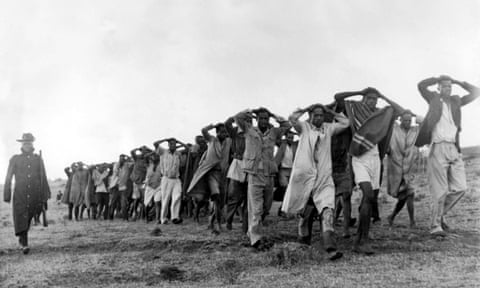Help us sue the British government for torture. That was the request Caroline Elkins, a Harvard historian, received in 2008. The idea was both legally improbable and professionally risky. Improbable because the case, then being assembled by human rights lawyers in London, would attempt to hold Britain accountable for atrocities perpetrated 50 years earlier, in pre-independence Kenya. Risky because investigating those misdeeds had already earned Elkins heaps of abuse.
Elkins had come to prominence in 2005 with a book that exhumed one of the nastiest chapters of British imperial history: the suppression of Kenya’s Mau Mau rebellion. Her study, Britain’s Gulag, chronicled how the British had battled this anticolonial uprising by confining some 1.5 million Kenyans to a network of detention camps and heavily patrolled villages. It was a tale of systematic violence and high-level cover-ups.
It was also an unconventional first book for a junior scholar. Elkins framed the story as a personal journey of discovery. Her prose seethed with outrage. Britain’s Gulag, titled Imperial Reckoning in the US, earned Elkins a great deal of attention and a Pulitzer prize. But the book polarised scholars. Some praised Elkins for breaking the “code of silence” that had squelched discussion of British imperial violence. Others branded her a self-aggrandising crusader whose overstated findings had relied on sloppy methods and dubious oral testimonies.
By 2008, Elkins’s job was on the line. Her case for tenure, once on the fast track, had been delayed in response to criticism of her work. To secure a permanent position, she needed to make progress on her second book. This would be an ambitious study of violence at the end of the British empire, one that would take her far beyond the controversy that had engulfed her Mau Mau work.
That’s when the phone rang, pulling her back in. A London law firm was preparing to file a reparations claim on behalf of elderly Kenyans who had been tortured in detention camps during the Mau Mau revolt. Elkins’s research had made the suit possible. Now the lawyer running the case wanted her to sign on as an expert witness. Elkins was in the top-floor study of her home in Cambridge, Massachusetts, when the call came. She looked at the file boxes around her. “I was supposed to be working on this next book,” she says. “Keep my head down and be an academic. Don’t go out and be on the front page of the paper.”
She said yes. She wanted to rectify injustice. And she stood behind her work. “I was kind of like a dog with a bone,” she says. “I knew I was right.”
What she didn’t know was that the lawsuit would expose a secret: a vast colonial archive that had been hidden for half a century. The files within would be a reminder to historians of just how far a government would go to sanitise its past. And the story Elkins would tell about those papers would once again plunge her into controversy.
Nothing about Caroline Elkins suggests her as an obvious candidate for the role of Mau Mau avenger. Now 47, she grew up a lower-middle-class kid in New Jersey. Her mother was a schoolteacher; her father, a computer-supplies salesman. In high school, she worked at a pizza shop that was run by what she calls “low-level mob”. You still hear this background when she speaks. Foul-mouthed, fast-talking and hyperbolic, Elkins can sound more Central Jersey than Harvard Yard. She classifies fellow scholars as friends or enemies.
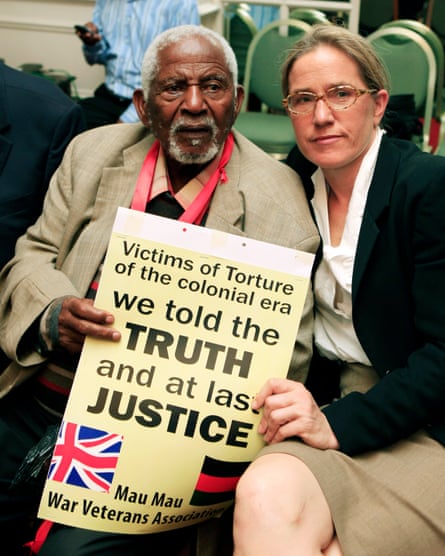
After high school, Princeton University recruited her to play soccer, and she considered a career in the sport. But an African history class put her on a different path. For her senior thesis, Elkins visited archives in London and Nairobi to study the shifting roles of women from Kenya’s largest ethnic group, the Kikuyu. She stumbled on to files about an all-female Mau Mau detention camp called Kamiti, kindling her curiosity.
The Mau Mau uprising had long fascinated scholars. It was an armed rebellion launched by the Kikuyu, who had lost land during colonisation. Its adherents mounted gruesome attacks on white settlers and fellow Kikuyu who collaborated with the British administration. Colonial authorities portrayed Mau Mau as a descent into savagery, turning its fighters into “the face of international terrorism in the 1950s”, as one scholar puts it.
The British, declaring a state of emergency in October 1952, proceeded to attack the movement along two tracks. They waged a forest war against 20,000 Mau Mau fighters, and, with African allies, also targeted a bigger civilian enemy: roughly 1.5 million Kikuyu thought to have proclaimed their allegiance to the Mau Mau campaign for land and freedom. That fight took place in a system of detention camps.
Elkins enrolled in Harvard’s history PhD programme knowing she wanted to study those camps. An initial sifting of the official records conveyed a sense that these had been sites of rehabilitation, not punishment, with civics and home-craft classes meant to instruct the detainees to be good citizens. Incidents of violence against prisoners were described as isolated events. When Elkins presented her dissertation proposal in 1997, its premise was “the success of Britain’s civilising mission in the detention camps of Kenya”.
But that thesis crumbled as Elkins dug into her research. She met a former colonial official, Terence Gavaghan, who had been in charge of rehabilitation at a group of detention camps on Kenya’s Mwea Plain. Even in his 70s, he was a formidable figure: well over six feet tall, with an Adonis-like physique and piercing blue eyes. Elkins, questioning him in London, found him creepy and defensive. He denied violence she hadn’t asked about.
“What’s a nice young lady like you working on a topic like this for?” he asked Elkins, as she recalled the conversation years later. “I’m from New Jersey,” she answered. “We’re a different breed. We’re a little tougher. So I can handle this – don’t worry.”
In the British and Kenyan archives, meanwhile, Elkins encountered another oddity. Many documents relating to the detention camps were either absent or still classified as confidential 50 years after the war. She discovered that the British had torched documents before their 1963 withdrawal from Kenya. The scale of the cleansing had been enormous. For example, three departments had maintained files for each of the reported 80,000 detainees. At a minimum, there should have been 240,000 files in the archives. She found a few hundred.
But some important records escaped the purges. One day in the spring of 1998, after months of often frustrating searches, she discovered a baby-blue folder that would become central to both her book and the Mau Mau lawsuit. Stamped “secret”, it revealed a system for breaking recalcitrant detainees by isolating them, torturing them and forcing them to work. This was called the “dilution technique”. Britain’s Colonial Office had endorsed it. And, as Elkins would eventually learn, Gavaghan had developed the technique and put it into practice.
Later that year, Elkins travelled to the rural highlands of Central Kenya to begin interviewing former detainees. Some thought she was British and refused to speak with her at first. But she eventually gained their trust. Over some 300 interviews, she heard testimony after testimony of torture. She met people such as Salome Maina, who had been accused of supplying arms to the Mau Mau. Maina told Elkins she had been beaten unconscious by Kikuyu collaborating with the British. When she failed to provide information, she said, they raped her using a bottle filled with pepper and water.
Elkins’s fieldwork brought to the surface stories repressed by Kenya’s policy of official amnesia. After the country gained independence in 1963, its first prime minister and president, Jomo Kenyatta, a Kikuyu, declared repeatedly that Kenyans must “forgive and forget the past”. This helped contain the hatred between Kikuyu who joined the Mau Mau revolt and those who fought alongside the British. In prying open that story, Elkins would meet younger Kikuyu who didn’t know their parents or grandparents had been detained; Kikuyu who didn’t know the reason they had been forbidden to play with their neighbour’s children was that the neighbour had been a collaborator who raped their mother. Mau Mau was still a banned movement in Kenya, and would remain so until 2002. When Elkins interviewed Kikuyu in their remote homes, they whispered.
Elkins emerged with a book that turned her initial thesis on its head. The British had sought to quell the Mau Mau uprising by instituting a policy of mass detention. This system – “Britain’s gulag”, as Elkins called it – had affected far more people than previously understood. She calculated that the camps had held not 80,000 detainees, as official figures stated, but between 160,000 and 320,000. She also came to understand that colonial authorities had herded Kikuyu women and children into some 800 enclosed villages dispersed across the countryside. These heavily patrolled villages – cordoned off by barbed wire, spiked trenches and watchtowers – amounted to another form of detention. In camps, villages and other outposts, the Kikuyu suffered forced labour, disease, starvation, torture, rape and murder.
“I’ve come to believe that during the Mau Mau war British forces wielded their authority with a savagery that betrayed a perverse colonial logic,” Elkins wrote in Britain’s Gulag. “Only by detaining nearly the entire Kikuyu population of 1.5 million people and physically and psychologically atomising its men, women, and children could colonial authority be restored and the civilising mission reinstated.” After nearly a decade of oral and archival research, she had uncovered “a murderous campaign to eliminate Kikuyu people, a campaign that left tens of thousands, perhaps hundreds of thousands, dead”.
Elkins knew her findings would be explosive. But the ferocity of the response went beyond what she could have imagined. Felicitous timing helped. Britain’s Gulag hit bookstores after the wars in Iraq and Afghanistan had touched off debate about imperialism. It was a moment when another historian, Niall Ferguson, had won acclaim for his sympathetic writing on British colonialism. Hawkish intellectuals pressed America to embrace an imperial role. Then came Bagram. Abu Ghraib. Guantánamo. These controversies primed readers for stories about the underside of empire.
Enter Elkins. Young, articulate and photogenic, she was fired up with outrage over her findings. Her book cut against an abiding belief that the British had managed and retreated from their empire with more dignity and humanity than other former colonial powers, such as the French or the Belgians. And she didn’t hesitate to speak about that research in the grandest possible terms: as a “tectonic shift in Kenyan history”.
Some academics shared her enthusiasm. By conveying the perspective of the Mau Mau themselves, Britain’s Gulag marked a “historical breakthrough”, says Wm Roger Louis, a historian of the British empire at the University of Texas at Austin. Richard Drayton of King’s College London, another imperial historian, judged it an “extraordinary” book whose implications went beyond Kenya. It set the stage for a rethinking of British imperial violence, he says, demanding that scholars reckon with colonial brutality in territories such as Cyprus, Malaya, and Aden (now part of Yemen).
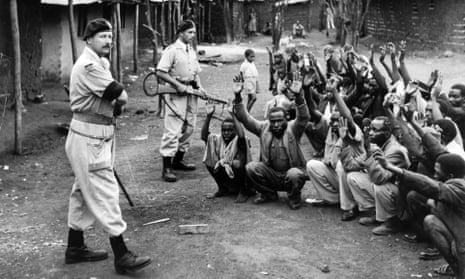
But many other scholars slammed the book. No review was more devastating than the one that Bethwell A Ogot, a senior Kenyan historian, published in the Journal of African History. Ogot dismissed Elkins as an uncritical imbiber of Mau Mau propaganda. In compiling “a kind of case for the prosecution”, he argued, she had glossed over the litany of Mau Mau atrocities: “decapitation and general mutilation of civilians, torture before murder, bodies bound up in sacks and dropped in wells, burning the victims alive, gouging out of eyes, splitting open the stomachs of pregnant women”. Ogot also suggested that Elkins might have made up quotes and fallen for the bogus stories of financially motivated interviewees. Pascal James Imperato picked up the same theme in African Studies Review. Elkins’s work, he wrote, depended heavily on the “largely uncorroborated 50-year-old memories of a few elderly men and women interested in financial reparations”.
Elkins was also accused of sensationalism, a charge that figured prominently in a fierce debate over her mortality figures. Britain’s Gulag opens by describing a “murderous campaign to eliminate Kikuyu people” and ends with the suggestion that “between 130,000 and 300,000 Kikuyu are unaccounted for”, an estimate derived from Elkins’s analysis of census figures. “In this very long book, she really doesn’t bring out any more evidence than that for talking about the possibility of hundreds of thousands killed, and talking in terms almost of genocide as a policy,” says Philip Murphy, a University of London historian who directs the Institute of Commonwealth Studies and co-edits the Journal of Imperial and Commonwealth History. This marred what was otherwise an “incredibly valuable” study, he says. “If you make a really radical claim about history, you really need to back it up solidly.”
Critics didn’t just find the substance overstated. They also rolled their eyes at the narrative Elkins told about her work. Particularly irksome, to some Africanists, was her claim to have discovered an unknown story. This was a motif of articles on Elkins in the popular press. But it hinged on the public ignorance of African history and the scholarly marginalisation of Africanist research, wrote Bruce J Berman, a historian of African political economy at Queen’s University in Kingston, Ontario. During the Mau Mau war, journalists, missionaries and colonial whistleblowers had exposed abuses. The broad strokes of British misbehaviour were known by the late 60s, Berman argued. Memoirs and studies had added to the picture. Britain’s Gulag had broken important new ground, providing the most comprehensive chronicle yet of the detention camps and prison villages. But among Kenyanists, Berman wrote, the reaction had generally been no more than: “It was as bad as or worse than I had imagined from more fragmentary accounts.”
He called Elkins “astonishingly disingenuous” for saying her project began as an attempt to show the success of Britain’s liberal reforms. “If, at that late date,” he wrote, “she still believed in the official British line about its so-called civilising mission in the empire, then she was perhaps the only scholar or graduate student in the English-speaking world who did.”
To Elkins, the vituperation felt over the top. And she believes there was more going on than the usual academic disagreement. Kenyan history, she says, was “an old boys’ club”. Women worked on uncontroversial topics such as maternal health, not blood and violence during Mau Mau. Now here came this interloper from the US, blowing open the Mau Mau story, winning a Pulitzer, landing media coverage. It raised questions about why they hadn’t told the tale themselves. “Who is controlling the production of the history of Kenya? That was white men from Oxbridge, not a young American girl from Harvard,” she says.
On 6 April 2011, the debate over Caroline Elkins’s work shifted to the Royal Courts of Justice in London. A scrum of reporters turned out to document the real-life Britain’s Gulag: four elderly plaintiffs from rural Kenya, some clutching canes, who had come to the heart of the former British empire to seek justice. Elkins paraded with them outside the court. Her career was now secure: Harvard had awarded her tenure in 2009, based on Britain’s Gulag and the research she had done for a second book. But she remained nervous about the case. “Good God,” she thought. “This is the moment where literally my footnotes are on trial.”
In preparation, Elkins had distilled her book into a 78-page witness statement. The claimants marching beside her were just like the people she had interviewed in Kenya. One, Paulo Nzili, said he had been castrated with pliers at a detention camp. Another, Jane Muthoni Mara, reported being sexually assaulted with a heated glass bottle. Their case made the same claim as Britain’s Gulag: this was part of systematic violence against detainees, sanctioned by British authorities. But there was one difference now. Many more documents were coming out.
Just as the hearings were set to begin, a story broke in the British press that would affect the case, the debate about Britain’s Gulag, and the broader community of imperial historians. A cache of papers had come to light that documented Britain’s torture and mistreatment of detainees during the Mau Mau rebellion. The Times splashed the news across its front page: “50 years later: Britain’s Kenya cover-up revealed.”
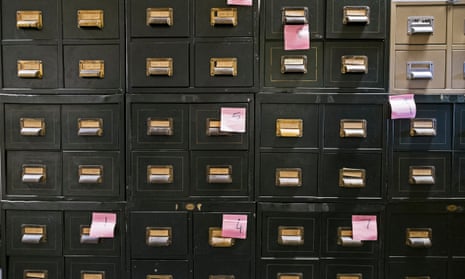
The story exposed to the public an archival mystery that had long intrigued historians. The British destroyed documents in Kenya – scholars knew that. But for years clues had existed that Britain had also expatriated colonial records that were considered too sensitive to be left in the hands of successor governments. Kenyan officials had sniffed this trail soon after the country gained its independence. In 1967, they wrote to Britain’s Foreign Office asking for the return of the “stolen papers”. The response? Blatant dishonesty, writes David M Anderson, a University of Warwick historian and author of Histories of the Hanged, a highly regarded book about the Mau Mau war.
Internally, British officials acknowledged that more than 1,500 files, encompassing over 100 linear feet of storage, had been flown from Kenya to London in 1963, according to documents reviewed by Anderson. Yet they conveyed none of this in their official reply to the Kenyans. “They were simply told that no such collection of Kenyan documents existed, and that the British had removed nothing that they were not entitled to take with them in December 1963,” Anderson writes. The stonewalling continued as Kenyan officials made more inquiries in 1974 and 1981, when Kenya’s chief archivist dispatched officials to London to search for what he called the “migrated archives”. This delegation was “systematically and deliberately misled in its meetings with British diplomats and archivists,” Anderson writes in a History Workshop Journal article, Guilty Secrets: Deceit, Denial and the Discovery of Kenya’s ‘Migrated Archive’.
The turning point came in 2010, when Anderson, now serving as an expert witness in the Mau Mau case, submitted a statement to the court that referred directly to the 1,500 files spirited out of Kenya. Under legal pressure, the government finally acknowledged that the records had been stashed at a high-security storage facility that the Foreign Office shared with the intelligence agencies MI5 and MI6. It also revealed a bigger secret. This same repository, Hanslope Park, held files removed from a total of 37 former colonies.
The disclosure sparked an uproar in the press and flabbergasted Elkins: “After all these years of being just roasted over the coals, they’ve been sitting on the evidence? Are you frickin’ kidding me? This almost destroyed my career.”
Events moved quickly from there. In court, lawyers representing the British government tried to have the Mau Mau case tossed out. They argued that Britain could not be held responsible because liability for any colonial abuses had devolved to the Kenyan government upon independence. But the presiding judge, Richard McCombe, dismissed the government’s bid to dodge responsibility as “dishonourable”. He ruled that the claim could move forward. “There is ample evidence even in the few papers that I have seen suggesting that there may have been systematic torture of detainees,” he wrote in July 2011.
And that was before historians had a chance to thoroughly review the newly discovered files, known as the “Hanslope disclosure”. A careful combing-through of these documents might normally have taken three years. Elkins had about nine months. Working with five students at Harvard, she found thousands of records relevant to the case: more evidence about the nature and extent of detainee abuse, more details of what officials knew about it, new material about the brutal “dilution technique” used to break hardcore detainees. These documents would probably have spared her years of research for Britain’s Gulag. She drew on them in two more witness statements.
Back in London, Foreign Office lawyers conceded that the elderly Kenyan claimants had suffered torture during the Mau Mau rebellion. But too much time had elapsed for a fair trial, they contended. There weren’t enough surviving witnesses. The evidence was insufficient. In October 2012, Justice McCombe rejected those arguments, too. His decision, which noted the thousands of Hanslope files that had emerged, allowed the case to proceed to trial. It also fed speculation that many more colonial abuse claims would crop up from across an empire that once ruled about a quarter of the earth’s population.
The British government, defeated repeatedly in court, moved to settle the Mau Mau case. On 6 June 2013, the foreign secretary, William Hague, read a statement in parliament announcing an unprecedented agreement to compensate 5,228 Kenyans who were tortured and abused during the insurrection. Each would receive about £3,800. “The British government recognises that Kenyans were subject to torture and other forms of ill-treatment at the hands of the colonial administration,” Hague said. Britain “sincerely regrets that these abuses took place.” The settlement, in Anderson’s view, marked a “profound” rewriting of history. It was the first time Britain had admitted carrying out torture anywhere in its former empire.
The lawyers were done fighting, but the academics were not. The Mau Mau case has fuelled two scholarly debates, one old and one new. The old one is about Caroline Elkins. To the historian and her allies, a single word summarises what happened in the High Court: vindication. Scholars had mistreated Elkins in their attacks on Britain’s Gulag. Then a British court, which had every reason to sympathise with those critics, gave her the fair hearing academia never did. By ruling in her favour, the court also implicitly judged her critics.
The evidence backing this account comes from Justice McCombe, whose 2011 decision had stressed the substantial documentation supporting accusations of systematic abuses. That “spoke directly to claims that, if you took out the oral evidence” in Britain’s Gulag, “the whole thing fell apart”, Elkins says. Then the Hanslope disclosure added extensive documentation about the scale and scope of what went on. At least two scholars have noted that these new files corroborated important aspects of the oral testimony in Britain’s Gulag, such as the systematic beating and torture of detainees at specific detention camps. “Basically, I read document after document after document that proved the book to be correct,” Elkins says.
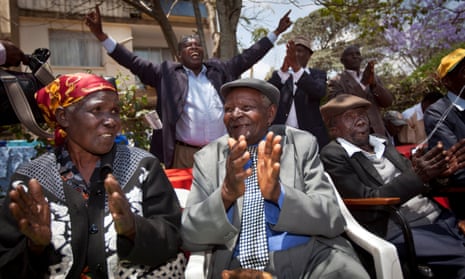
Her victory lap has played out in op-eds, interviews and journal articles. It may soon reach an even bigger audience. Elkins has sold the film rights for her book and personal story to John Hart, the producer of hits including Boys Don’t Cry and Revolutionary Road. An early summary of the feature film he is developing gives its flavour: “One woman’s journey to tell the story of the colonial British genocide of the Mau Mau. Threatened and shunned by colleagues and critics, Caroline Elkins persevered and brought to life the atrocities that were committed and hidden from the world for decades.”
But some scholars find aspects of Elkins’s vindication story unconvincing. Philip Murphy, who specialises in the history of British decolonisation, attended some of the Mau Mau hearings. He thinks Elkins and other historians did “hugely important” work on the case. Still, he does not believe that the Hanslope files justify the notion that hundreds of thousands of people were killed in Kenya, or that those deaths were systematic. “Probably most of the historical criticisms of the book still stand,” he says. “I don’t think the trial really changes that.”
Susan L Carruthers feels the same about her own criticism of Britain’s Gulag. Carruthers, a professor of history at Rutgers University at Newark, had cast doubt on Elkins’s self-dramatisation: her account of naively embarking on a journey of personal discovery, only to see the scales drop from her eyes. She finds that Elkins’s current “narrative of victimisation” also rings a bit false. “There’s only so much ostracism one can plausibly claim if you won a Pulitzer and you became a full professor at Harvard – and this on the strength of the book that supposedly also made you outcast and vilified by all and sundry,” she says. “If only all the rest of us could be ostracised and have to make do with a Pulitzer and a full professorship at Harvard.”
The second debate triggered by the Mau Mau case concerns not just Elkins but the future of British imperial history. At its heart is a series of documents that now sits in the National Archives as a result of Britain’s decision to make public the Hanslope files. They describe, in extensive detail, how the government went about retaining and destroying colonial records in the waning days of empire. Elkins considers them to be the most important new material to emerge from the Hanslope disclosure.
One morning this spring, I accompanied Elkins as she visited the National Archives to look at those files. The facility occupies a 1970s-era concrete building beside a pond in Kew, in south-west London. A blue cord held together the thin, yellowed pages, which smelled of decaying paper. One record, a 1961 dispatch from the British colonial secretary to authorities in Kenya and elsewhere, states that no documents should be handed over to a successor regime that might, among other things, “embarrass” Her Majesty’s Government. Another details the system that would be used to carry out that order. All Kenyan files were to be classified either “Watch” or “Legacy”. The Legacy files could be passed on to Kenya. The Watch files would be flown back to Britain or destroyed. A certificate of destruction was to be issued for every document destroyed – in duplicate. The files indicate that roughly 3.5 tons of Kenyan documents were bound for the incinerator.
“The overarching takeaway is that the government itself was involved in a very highly choreographed, systematised process of destroying and removing documents so it could craft the official narrative that sits in these archives,” Elkins told me. “I never in my wildest dreams imagined this level of detail,” she added, speaking in a whisper but opening her eyes wide. “I imagined it more of a haphazard kind of process.”
What’s more, “It’s not just happening in Kenya to this level, but all over the empire.” For British historians, this is “absolutely seismic,” she said. “Everybody right now is trying to figure out what to make of this.”
Elkins laid out what she makes of this development in a 2015 essay for the American Historical Review. Broadly speaking, she thinks end-of-empire historians have largely failed to show scepticism about the archives. She thinks that the fact that those records were manipulated puts a cloud over many studies that have been based on their contents. And she thinks all of this amounts to a watershed moment in which historians must rethink their field.
The issue of archival erasure figures prominently in Elkins’s next book, a history of violence at the end of the British empire whose case studies will include Kenya, Aden, Cyprus, Malaya, Palestine and Northern Ireland. But if the response to her latest claims is any indication, her arguments will once again be controversial. The same document shenanigans that leave Elkins wide-eyed prompt several other historians to essentially shrug. “That’s exactly what you would expect of a colonial administration, or any government in particular, including our own,” laughs Wm Roger Louis. “That’s the way a bureaucracy works. You want to destroy the documents that can be incriminating.”
Murphy says Elkins “has a tendency to caricature other historians of empire as simply passive and unthinking consumers in the National Archives supermarket, who don’t think about the ideological way in which the archive is constructed”. They’ve been far more sceptical than that, he says. Historians, he adds, have always dealt with the absence of documents. What’s more, history constantly changes, with new evidence and new paradigms. To say that a discovery about document destruction will change the whole field is “simply not true”, he says. “That’s not how history works.”
Some historians who have read the document-destruction materials come away with a picture of events that seems less Orwellian than Elkins’s. Anderson’s review of the evidence shows how the purging process evolved from colony to colony and allowed substantial latitude to local officials. Tony Badger, a University of Cambridge professor emeritus who monitored the Hanslope files’ release, writes that there was “no systematic process dictated from London”.
Badger sees a different lesson in the Hanslope disclosure: a “profound sense of contingency”. Over the decades, archivists and Foreign Office officials puzzled over what to do with the Hanslope papers. The National Archives essentially said they should either be destroyed or returned to the countries from which they had been taken. The files could easily have been trashed on at least three occasions, he says, probably without publicity. For a variety of reasons, they weren’t. Maybe it was the squirrel-like tendency of archivists. Maybe it was luck. In retrospect, he says, what is remarkable is not that the documents were kept secret for so many years. What is remarkable is that they survived at all.
This article first appeared in the Chronicle of Higher Education.
